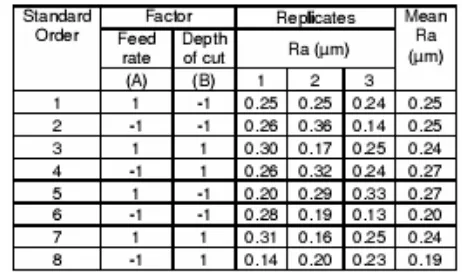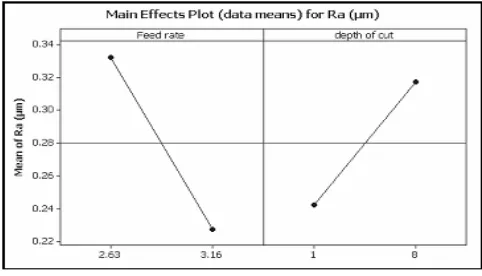CAD/CAM/CAE & Design of Manufacturing
403
Experimental Investigation of Significance Parameters in Surface
Grinding – Quality Evaluation
R Jamaludin, M S Kasim, Sivarao, MR Salleh
Department of Manufacturing ProcessFaculty of Manufacturing Engineering
Universiti Teknikal Malaysia Melaka, Locked Bag 1200, Ayer Keroh, 75450 Malacca, Malaysia
Tel: +60136245344, +60124460034 E-mail: [email protected]
Abstract - The resurgence of the high quality and precision parts by manufacturing industries has enabled the development of ultra-precision machine tools. Surface roughness and tolerances are the most critical quality measures of any mating mechanical parts produced. The quality evaluation requirement of manufactured parts is becoming the prime factor as it determines not only the esthetics values, but also the lifespan and function of its purpose. Grinding is one the most popular methods of machining hard materials which widely known as random point cutting. The main aim of this experimental work is to investigate the significant parameter(s) in surface grinding which affect the machined surface roughness. Two work materials, namely, mild steel and carbon steel have been investigated with two variables; feed rate and depth of cut for the response of surface roughness totaling eight experiments with three replications. Statistical approach using Design of Experiment (DOE) has been carried out in this investigation. The ANOVA results of the analysis have been based to determine the significance and correlation of the input and output parameters.
Keywords: surface grinding, surface roughness, ANOVA, DOE.
I. INTRODUCTION
Surface roughness has been one the most important quality measures in many mechanical products. As early as in 1984, Tarbekin has brought its significant to our attention [1]. The impact of two factors, namely the depth of cut and work piece materials on surface roughness is depicted in (Grover, 1996). In obtaining an excellent surface finish of a finished product, grinding machine is a preferred common machine tool as it permits the production of extremely fine tolerances with improved surface finish and accuracy of the part [3]. Due to the dimensional accuracy capability of grinding process, interchangeable manufacture has become commonplace in most of the metal cutting industries.
Many research works show that, grinding process capable in eliminating the need of conventional machining. In another word, a mechanical part finished by grinding, seldom requires a secondary machining process for the betterment of its surface. Nowadays, grinding is applied extensively onto both hardened and unhardened metallic parts of which the finish can be achieved to 10ths of microns.
The mechanism behind the formation of surface roughness is very dynamic, complicated, and process dependent. It is very difficult to analyze its value through theoretical analysis [4]. Therefore, statistical approaches with empirical work are commonly used. Knowing Design Of Experiments (DOE) is the most powerful and common analytical tool used to overcome the limitations of analysis in grinding, as it provide a sound information about the analysis with optimal number of work runs. Therefore, the vast and reliable statistical tool is used in this analytical research work. The fractional factorial design approach has been used to study the main and interaction effects of the input factors upon obtaining the best response, surface roughness, Ra.
Figure 1. The Six Basic Elements Involved In Basic Grinding (Marinescu, 2001)
II. BASIC LITERATURE
Knowing the dynamics of grinding process is the most complex, the cause of the resulting phenomenon is very subjective. Hence, the literature shows there are few main factors which can influence the surface finish. Among them are:
A. Grinding vibration
National Conference on Design and Concurrent Engineering
404 (Marinescu, 2001). In order to eliminate the effect of vibration on the grinding process, unbalance of the grinding wheel should be detected using a vibration sensor, followed by balancing a grinding wheel. Regenerative chatter can be further reduced by taking necessary actions as listed below:
• Modification of grinding condition
• Increase the dynamic stiffness of the mechanical system.
• Shifting the vector locus of the dynamic
compliance to positive real part.
• Disturbing the regenerative effects
B. Grinding wheel wear
During machining, the wear of grinding wheel gives an impact on the surface roughness. As a result of process forces during grinding, a grinding wheel is subjected to modification by process of wheel wear (Marinescu, 2001). Wear leads to changed process conditions and quality deviations in the component. Loss of grinding wheel sharpness leads to higher grinding forces, which may entail dynamic and thermal deflections between the grinding wheel and workpiece. Surface disruptions can be traced back to mechanical thermal alternating pressures opening up grain boundaries and cleavage planes (Marinescu, 2001). This leads structure to face changes, fatigue, cracks, and separation of single particles causing breakage and cutting material failure. The wear of a grinding wheel is a result of material loss on wheel surface due to relative mechanical contact movement of wheel to workpiece.
C.Coolant
Coolant is one of factors which affect workpiece surface roughness. The velocity of the coolant during machining can reduce or control the gained temperature which can produce a good surface roughness. Cooling lubricant additives are also added to avoid corrosion through adsorption on the work surface or chemical reactions with the faces of the workpiece (Marinescu, 2001). Tangential grinding force and grinding power can be minimized and heat is reduced by friction reduction using coolant lubricant with a strong lubricating effect. Successful cooling leads to quick heat dissipation keep active partners below critical temperature. The lubricating capacity of a lubricant depends on its contents and the viscosity influences the lubricating capacity of water immiscible and water-miscible type.
III. EXPERIMENTAL PROCEDURE
This experiment is a comparative quality investigation of which it compares the surface quality of two different work materials, namely, AISI 1020 and AISI 1045. Two variables, feed rate and depth of cut were investigated at two levels. A DOE matrix was developed based on 2k factorial design and
later randomized to prevent biasing data sets. Four experiments were figured based on this formulation and they were replicated once totaling of eight experiments. Table 1 shows the factors and levels used in this investigation. The surface roughness was measured at three different spots with centre line average methodology and they were based in this investigation. The Mitutoyo SJ301 profilometer was used to capture the readings of surface roughness. The sampling length of 0.8 has been implemented for better Ra measurement. The observed values of three different spots together with their mean are presented in Table 2 and Table 3 for mild steel and carbon steel work material respectively.
Table 1. Factors and Level of Experiments
Table 2. Design of Experiment and Data for Mild Steel Specimen
CAD/CAM/CAE & Design of Manufacturing
405 IV. RESULT AND DISCUSSION
In this section, the two different work materials were analyzed and compared for some specific investigation. The comparative analysis is based on their scattered plot, main effect and interaction effect.
Figure 2. Normal Probability Plot of Standardized Effects for Mild Steel
Figure 3. Normal probability plots of the standardized effects for carbon steel
Figure 2 and Figure 3 show the scattered plot for two different work materials analyzed. The work materials were mild steel, AISI 1020 and carbon steel, AISI 1045. As for mild steel work, the scatter shows that both the speed and depth of cut are significant, where else, the carbon steels analysis indicates only feed rate is significant. The depth of cut in this scenario is considered non-significant.
Figure 4. Main Effects Plot for Mild Steel
Figure 5. Main Effects for Carbon Steel
The main effect of the parameters to the levels selected is clearly visible for both materials. Figure 4 show that mild steel machining has better surface roughness at lower levels which is below 0.23 microns. The depth of cut gives a very small range of difference in the change of levels. The change of levels from lower to higher deviates only 0.01 microns. Figure 5 shows the inverse effect of both the variables onto response. The lower level setting for depth of cut produces better surface roughness as compared to higher level. Whereas, the output of feed rate settings inverse proportional to the output.
Figure 6. Interaction Plot for Mild Steel
National Conference on Design and Concurrent Engineering
406 V. CONCLUSION
The main aim of the investigation is considered successful with the findings of differences in variable significance in surface grinding. The variation in work material as well as controllable variables in two levels has resulted significant findings. It is concluded that the significant variables for the Mild Steel AISI 1020 are both the feed rate and depth of cut. Where else, for carbon steel AISI 1045 material, the significant parameter is only feed rate. The depth of cut manipulation was found not contributing much in response an impact to the surface roughness of the workpiece. The analytical tool was also successfully utilized to gain the dynamic conditions of grinding process via a full factorial statistical approach.
REFERENCES
[1] Chang, X.F (2001). “An Experimental Study of the Impact of Turning Parameters on Surface Roughness”. International Engineering Research Conference. Paper No:2036
[2] Groover, M (1996). “Fundamentals of Modern Manufacturing”. New York: Wiley.
[3] Krar, S.F, & Grill A.R (2006. “Technology of Machine Tools”. New York: McGraw Hill.
[4] Julie, Z.Z, Joseph, C.C. “Surface roughness optimization in an end-milling operation using the Taguchi design method”. Journal of Material Processing Technology. Vol, 184, pp 233-234.


